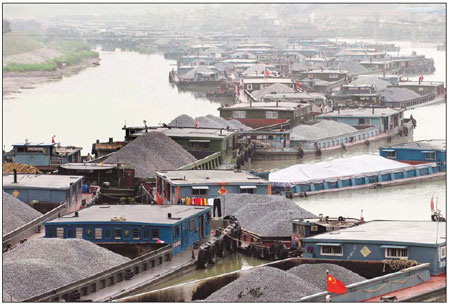Society
Shipping in crisis as water levels plunge
(China Daily)
Updated: 2011-05-07 07:45
 |
Large Medium Small |
|
Scores of cargo ships are grounded in Dongtiaoxi River in Huzhou city, East China's Zhejiang province, on Wednesday. Low water levels due to the drought caused the transport logjam. Zhou Yushun/Xinhua |
WUHAN - Authorities are rushing to clear snarled shipping traffic and prevent accidents along the drought-stricken Yangtze River, a key route to fast-growing markets in inland China.
Several sections of the drought-stricken Yangtze River, China's longest waterway, may pose dangers for shipping traffic, the Changjiang (Yangtze River) Maritime Safety Administration said on Friday.
Relevant government units have been asked to strengthen traffic management on the river and ensure safety on the key routes, according to the administration's statement.
The water level of the Yangtze River has dropped sharply since February, with its middle reaches falling to levels not seen in 50 years. In addition, the water level near the river's Three Gorges Dam is at five-year low.
In the past three days, maritime safety bureaus in the cities of Chongqing, Wuhan and Huangshi have issued alarms and assisted ships that have run aground.
The drought has reduced water levels in the river to a "worrying level", said Wang Xiandeng, head of the Changjiang (Yangtze River) Wuhan waterway bureau.
Dozens of emergency teams have been deployed along the river's middle reaches to help prevent accidents, said a notice on the government's website. It said water levels at some measuring stations had dropped to record low levels.
Although the 6,300-kilometer Yangtze River is better known for its summer flooding, a severe drought in northern and eastern China has sharply reduced runoff into the river, which stretches from far western Qinghai to China's Pacific coast.
The prolonged dry spell has stunted the winter wheat crop, sapped hydroelectricity production and threatened drinking water supplies for at least 3 million people. Much of vast Poyang Lake, a wetland that often absorbs floodwaters during the typhoon season, is now a flat dusty plain.
The problem is adding urgency to plans announced earlier this week to spend billions of dollars to dredge much deeper channels through the lower reaches of the heavily silted waterway. The dredging is a crucial step in an effort to develop major inland ports to handle growing cargo volume as manufacturers shift production away from heavily developed coastal regions.
Shanghai itself, at the mouth of the Yangtze, has long had to conduct dredging operations to keep its ports accessible, and in recent years built a new deepwater port on an offshore island to help meet soaring cargo transport demand in the region.
State media reported that neighboring Jiangsu province, just upriver, and the Ministry of Transport plan to spend 18 billion yuan ($2.7 billion) on deepening navigation channels along the lower Yangtze to enable 50,000-ton vessels, such as bulk freighters, to travel as far as the provincial capital, Nanjing.
But Wuhan and Chongqing, major cities further inland, face even larger hurdles: the water level at Hankou, in Wuhan, was only 2.87 meters on Wednesday, below its dry-season average level of 4 meters.
The Danjiangkou Reservoir, which is part of China's massive south-to-north water diversion project, is also seeing extremely low water levels. By early Wednesday morning, the reservoir depth measured 135.18 meters, nearly 4 meters lower than the minimum accepted level.
Agencies
(China Daily 05/07/2011 page3)
